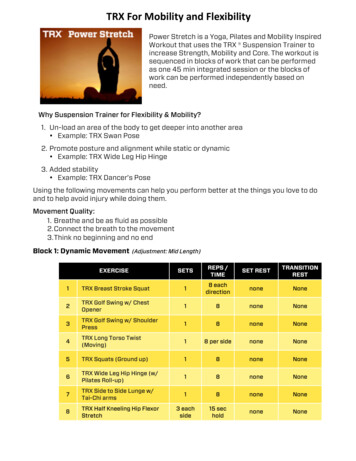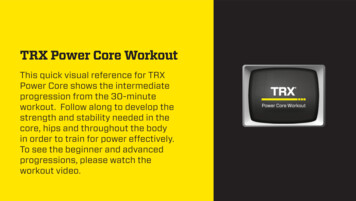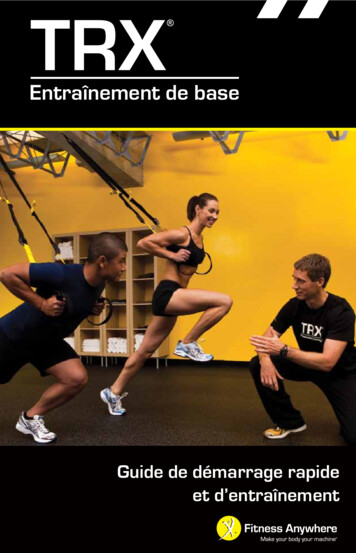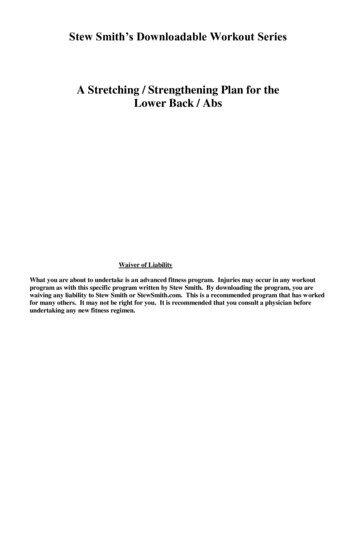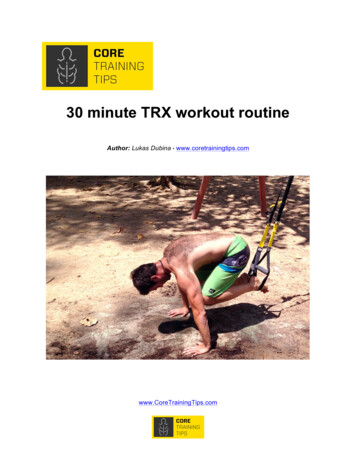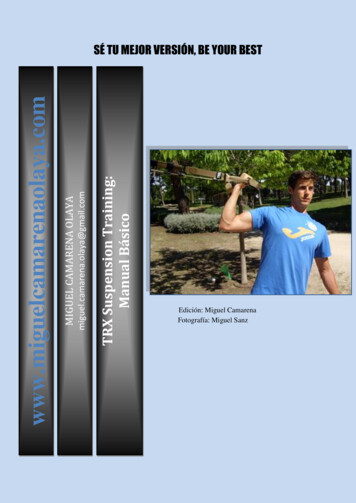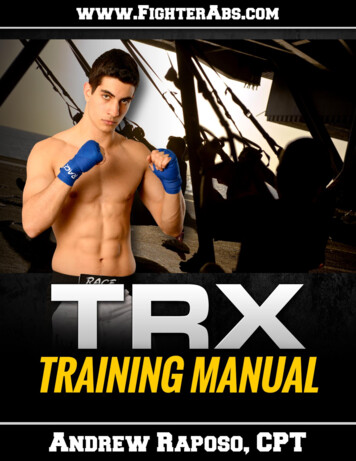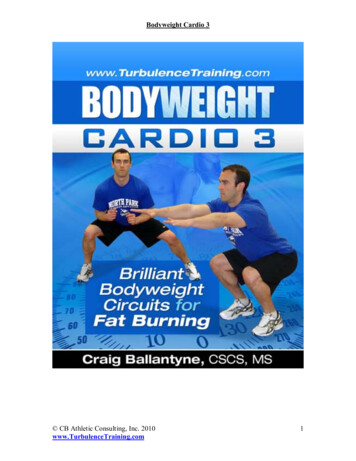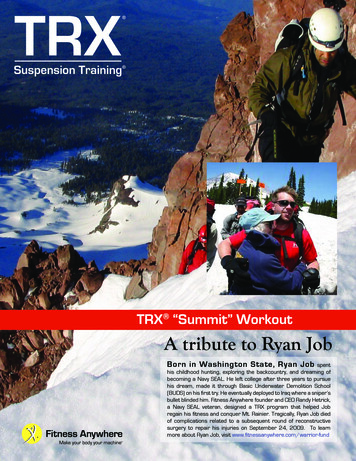
Transcription
TRX “Summit” WorkoutA tribute to Ryan JobBorn in Washington State, Ryan Jobspenthis childhood hunting, exploring the backcountry, and dreaming ofbecoming a Navy SEAL. He left college after three years to pursuehis dream, made it through Basic Underwater Demolition School(BUDS) on his first try. He eventually deployed to Iraq where a sniper’sbullet blinded him. Fitness Anywhere founder and CEO Randy Hetrick,a Navy SEAL veteran, designed a TRX program that helped Jobregain his fitness and conquer Mt. Rainier. Tragically, Ryan Job diedof complications related to a subsequent round of reconstructivesurgery to repair his injuries on September 24, 2009. To learnmore about Ryan Job, visit www.fitnessanywhere.com/warrior-fund
Ryan Job had never done any serious mountaineeringprior to climbing Mt Rainier so in order to prepare hisbody for the challenge, he trained seven days a weekand tackled this special TRX Summit workout designedby Fitness Anywhere. Whether you are preparing tosummit your first mountain or just looking for a greatnew challenge, this program will take your fitness tonew heights.Complete this workoutfour times per weekor incorporate thesemoves into your normalroutine for a musclesearing experience youwon’t forget.TRX “Summit” WorkoutTRX SINGLE LEG SQUAT1 minute each leg (2-3 sets)Crossing Balance Lunge
TRX BALANCE LUNGE MATRIX30 seconds per each leg ofeach exercise in a superset(2-3 sets)TRX Crossing Balance LungeTRX Regular Balance LungeTRX Abducted Balance Lunge
TRX LUNGE w/pack*15 reps each leg (2-3 sets)*Ryan Job tested his balance and added weight to thisexercise by wearing his packTRX Single Arm Chest Press60 sec each arm(2-3 sets)TRX SINGLE ARM ROW60 seconds each arm(2-3 sets)TRX HIGH ROW MATRIX4 reps to each hand position(2-3 sets) Palms UpThumbs UpPalms DownThumbs DownTip: Remember to keep yourelbows high throughout allexercises.
TRX SHOULDER SEQUENCE (T, W, Y Raise)4 reps in each position(2-3 sets)Start PositionTRX T Shoulder RaiseTRX W Shoulder RaiseTRX Y Shoulder Raise
TRX POSTURAL SQUATHold for 60 seconds at bottomof position(2-3 sets)TRX SIDE PLANK w/taps60 seconds each side(2-3 sets)
TRX CRUNCH MATRIX(Plank, Crunch, Oblique Crunch)Sequence through each exercise for 60 seconds(2-3 sets)Tip: Add a push-up for more intensityCopyright 2009 San Francisco, California. All rights reserved. TRX , Make your body your machine , Suspension Training ,TRX Suspension Trainer , and the X-Globe logo are trademarks of Fitness Anywhere, Inc. in the U.S. and other countries.TRX Oblique Crunch RightTRX Oblique Crunch LeftTRX CrunchTRX Plank (Starting Position)
Ryan Job, the Ultimate FighterOn August 2, 2006, Ryan Job was on anotherwise typical SEAL foot patrol in Iraq whenhe heard a gunshot crack through the silentnight. It would be the last thing he heard beforehe went blind. “I was shot by a sniper throughthe right eye. The round fragmented inside myhead and destroyed the right eye and the opticnerve of my left eye leaving me blind in botheyes. It also severed my olfactory nerve leavingme with no sense of smell or eyesight.” Twodays later, Job woke up in the VA hospital inBethesda, MD. “I couldn’t figure out where I wasand why I could hear people but couldn’t see. Ithought there were bandages on my face.”During the summer of 2009 after enduring atotal of 18 surgeries and counting, Job, who hadbecome the spokesman for both Camp Patriotand the San Diego-based Challenged AthletesFoundation, returned to Rainier. But on thisexpedition he passed on the glory of the summitfor the backbreaking task of humping gear upand down the mountain to support the otherwounded warriors making the climb. Haulinggear up and down a mountain might not soundlike fun, but Job savored the challenge—and thereward that awaited him every time he returnedto base camp. “If you spend 6-9 hours climbingyou burn 6,000-9,000 calories and you can eatwhatever you want. There’s a pizza place at thebottom, and I got to eat a ton of pizza.”“Never bea quitter.”Job’s road from Iraq to the summit of Rainier—and endless pizza at the bottom—started offin rural Washington where he spent his youthbackpacking, tracking and hunting bears, deer,and elk in old growth forests. Job wrestled inhigh school and played rugby at WashingtonState, but never considered himself anoutstanding athlete or student. His singularmission in life was to serve his country as aNavy SEAL. “The only reason I went into theNAVY was to become a SEAL. I had a privatepilot’s license and wanted to fly jets, but I wantedto do both: fly and be a SEAL. The thing thatappealed to me most was the unconventionalJob wanted to be a SEAL so badly that he leftWashington State in 2002 after three years ofschool to enlist in the Navy. He negotiated aclause in his enlistment contract that guaranteedno matter what, he’d get a shot at BasicUnderwater Demolition School, or BUDS, thefirst testing phase for prospective SEALs. “Rightafter boot camp and my A school, I went straightto BUDS. The A school I picked was aviationordinance, and the only reason I picked it was toget to BUDS more rapidly. I started BUDS fourmonths after I went in.”When he made it to BUDS, he found thechallenge he’d been waiting for his wholelife—and then some. “BUDS was a major kickin the nuts.” But he made it. After graduatingfrom BUDS in 2004, he joined SEAL Team 3 andspent the next year training with his platoon. InApril 2006, his platoon deployed to Iraq and Jobspent the next four months performing specialoperations. “I shouldn’t go into much detail aboutwhere I went in Iraq. We did all types of SEALstyle missions. Let’s just say my platoon madeour deployment worth it. If there was a bad guy,they paid the man.” That doesn’t mean he had fundoing it, though. “There is nothing about combatthat I enjoy except the fact that I did my part of it.”Two days after being shot, Job was back inthe States at the VA hospital in Bethesda, MDwhere he faced surgery after surgery for thenext six weeks. Navy SEALs and other specialoperators have the fitness, mindset and skillsof professional athletes and put those aptitudesto the test every day in combat. Before theaccident, Job’s fitness and combat-readinesshad been central to his identity. Now he couldn’teven go to the bathroom on his own.“When I was shot, I went from being in the top 1%of most physically capable people in the world tobeing in the bottom 1% in a fraction of a second.I was skinny and weak and didn’t resemble aSEAL anymore. I spent almost two months flaton my back in a hospital bed with my musclesatrophying. It’s incredible how far backwards yourfitness can slide during such a short period oftime. I was pretty depressed about the physicalstate I’d deteriorated into and I knew I hadmonths of inpatient rehab left to go to get meback to my normal life.” As trying as his situationwas, Job never gave up hope. “In the SEALteams, we had a saying. When all else fails, planB is just make it happen. Never be a quitter.”The community of current and former SEALoperators takes care of its own, and a steadystream of SEALs past and present showed upto support Job. One day, CAPT Rick Woolard(Ret.), a former Commanding Officer of SEALTeam SIX visited Job in the hospital. WoolardPhoto Courtesy of the Seattle TimesIt’s the kind of nightmare scenario no one, noteven a Navy SEAL, is emotionally or physicallyequipped to handle gracefully. Less than twoyears later, Job fought his way back into shapewith the help of the TRX and Fitness AnywhereCEO Randy Hetrick to stand atop the summitof Mount Rainier as part of an expeditionwith Camp Patriot, a nonprofit organizationcreated by Navy vet Micah Clark to facilitatetransformative expeditions and outdoorrecreation for injured vets.nature of the SEAL community compared to thenormal military, the kinds of missions they do.”asked Job what he would ask for if he couldhave anything. Job didn’t say, “I wish I had myeyesight back,” or, “I wish I could taste my food,”or, “I wish I could use the bathroom withoutsomeone helping me.” The only thing he wishedfor was a way to work out on his own. In a questto fulfill Job’s wish, Woolard got in touch withRandy Hetrick, the former Navy SEAL SquadronCommander who started Fitness Anywhere.A mutual friend in the SEAL community relayedthe tale of Woolard’s visit with Job to Hetrick.Hetrick knew he had a solution for Job in theform of the TRX. “It was like, hey here’s atraining system he can do blind without anyassistance. I knew he could challenge himselffrom his current elementary level back throughthe most elite levels. I liked that there wasn’tanything he could benchmark his effort againston the TRX. If Ryan had jumped on a benchpress and could only bench 100 pounds whenbefore he could bench 300, he might’ve beendiscouraged. With the TRX he was able tostart from scratch and it gave him something topractice,” says Hetrick. When Job transferred tothe Palo Alto VA in December, 2006 for rehabto help him adjust to being blind, Hetrick had aspecial TRX workout protocol waiting for him.The TRX can be set up literally almostanywhere—including in a hospital room. Thiswas key for Job, because his biggest problemwith working out was that until he got the TRX hehad to have someone else help him work out andtransport him to and from the weight room. Whena TRX arrived in Job’s hospital room, his wish
was fulfilled and he started to work out again. Thenext step was conquering the beast of a trainingregimen that Hetrick had waiting for him.with? And where am I going to workout? TheTRX is very efficient. All of the motions aremoving your own bodyweight.“I spent weeks developing that first routine,” saysHetrick. “I had this hypothesis that many of ourhundreds of exercises would be exemplary forblind people. But I didn’t know for sure withouttesting it. So I donned this pair of blinder shadesfor air travel and started with squats, rows andcurls and other stable positions. Those exercisesturned out to be no big deal, I could do themjust as well with my eyes closed as open. So Istarted pushing the envelope all the way out.“I like the fact that you can stretch on it, too—flexibility is important to fitness also. I like the factthat you can travel with it and take it, well, fitnessanywhere! I like the fact that you can incorporateit into any training routine whether you’re arunner or swimmer or weightlifter. You really candevelop a program on it for any type of sport.”Including mountaineering, as Job found out. Jobhad never done any serious mountaineering priorto his Rainier attempt so in order to prepare hisbody for the challenge, he trained seven days aweek and tackled a special TRX mountaineeringprotocol designed by Fitness Anywhere’s headtraining guru, Fraser Quelch.“It turns out you can do just about all of the TRXexercises with your eyes closed. You never haveto take your hands off the harness. I could gothrough a whole workout with my eyes closedbecause I know how to adjust it, how far it shouldbe from the floor. You lay down, you put your feetin. You stand up, you hold onto the handles. Younever lose contact with it. You can’t get a visiblehorizon when you’re blind, so the TRX almostbecomes a visible horizon. You know where youare because when you tug on the straps youknow they’re up and in front of you or up andbehind you, etc.”Once he settled in Scottsdale, the TRX remaineda cornerstone of Job’s training. “I run on atreadmill, swim, and bike and lift weights forstrength and power, but I also use my TRX. It’sreally an efficient way to get a workout done.It’s something I always have an option to do. Ittotally eliminates my problem of transportation toand from the gym or who am I going to workoutOnce on the mountain, Job found himself readyto face the challenge rising more than 14,000feet in front of him. The Camp Patriot team hadreached the summit with a blind veteran theyear before in 2007. The guides used the samesystem they developed on that climb to enableJob to ascend safely. Job was roped to a sightedguide five feet in front of him. “I could follow himbased on the tension and direction of the rope.”A second guide followed five feet behind Job andverbally described the terrain. “I used trekkingpoles in both hands for stability and steeperterrain and for finding obstacles, just like I’d usea cane.” The system worked and Job and theteam successfully made the summit.“I attribute summit success and making it tothe top to the team, first of all. Second, fitnesswas a huge key for me. Everyone else couldsee what they were walking up and take theright height, length and direction of steps. I’dhave to pick my foot up a little farther eachtime, stride a little farther, spend more time oneach step just to identify where to put my foot. Ihad to use my upper body to pull myself up themountain sometimes and support my upper bodyin addition to finding the footing in front of mewith my foot, testing it and seeing if I could putmy foot down safely. My process was twice asenergy consuming as a sighted person.”The TRX and an iron will helped to propel Jobto heights that most sighted people don’t evendare to dream of attaining. He made motivatingother Wounded Warriors to reach beyond theirdisabilities a priority with his work as spokesmanfor the Challenged Athletes Foundation andCamp Patriot. Working with Job gave Hetricka powerful realization, too. “Ryan was thefirst Wounded Warrior we were able to helpplay the deck that he’d been dealt with a newhand. That was really exciting and one of themost rewarding things I’ve done since leavingthe SEAL teams.” The experience resonatedso strongly with Hetrick’s core values andthe core values of Fitness Anywhere that itled directly to the development of the FitnessAnywhere Warrior Fund, a program that providesequipment, training and encouragement toinjured athletes and soldiers. “We learned thatthe TRX is great for all Wounded Warriors,whatever their injuries. The two things the TRXgives Wounded Warriors are independenceand the ability to pursue fitness wherever theywant to or are able to, whether it’s at home, ina hospital room, with a trainer or therapist, oralone.” Five dollars of every TRX Force TrainingKit sold through FitnessAnywhere.com goes tosupport the effort. Click here to buy a TRX ForceTraining Kit and support the fund today.Support the:go to fitnessanywhere.com/warrior-fundCopyright 2009 San Francisco, California. All rights reserved. TRX , Make your body your machine , Suspension Training ,TRX Suspension Trainer , TRX Force and the X-Globe logo are trademarks of Fitness Anywhere, Inc. in the U.S. and otherThroughout his rehab in Palo Alto, Job continuedto train on the TRX. When he finished that aspectof his rehab, he settled in Scottsdale, AZ wherelived with his wife, Kelly, earned a businessdegree at Jones International University, andworked in the defense industry. While Job’sindomitable spirit helped him adapt to life afterhis injury, he was thankful he had the TRX to helpkeep him sane and get back into shape. It was anexperience he hoped that more wounded warriorswould have the opportunity to experience. “I’dlike to see the VA buy it for all wounded servicepersonnel. I think it’s a reasonable request. Ithink it is to the benefit of the government, too. Ifthe government enables an injured guy to keephimself in shape by giving him a TRX, then hestays healthy and out of the system and takes upless resources from the government.”Photo Courtesy of the Seattle TimesHetrick met with Job and introduced him to hisnew workout protocol during a hardcore sessionon the TRX in the garage of Hetrick’s SanFrancisco home. Job was gassed, but thrilled.“The timing of when I started using the TRXwas good for my specific injury because I waslearning how to be blind,” says Job. “I had beenblind six weeks and was learning how to doeverything blind. The TRX works on your spatialorientation, your body position, your balance, it’ssomething that teaches you how to do physicalactivity and coordinate yourself blind. Besides allof the strength training and physical training, itreally enhanced my proprioception.”*Take a look at the workouts attached to give theTRX protocol Ryan used to prepare to tackle Mt.Rainier a try.He didn’t let that get in the way of enjoying theclimb, though. “I love the mountains, I love theoutdoors. I was very tired at many points but I washappy the whole time, excited the whole time. Iloved being able to go back up to Washingtonstate because that’s where I grew up. I liked thecold air on my face. I’m very sensitive to soundnow. I like the sound of things when there’ssnow on the ground. It sounds very different, it’smuffled, echoes sound different, but I can stillhear when a cliff or rock wall is next to me. Onthe summit there’s nothing above your head andnothing on your sides, just entirely open space.”The team made it to the summit and back down tothe parking lot in just four days. “I was recoveredfrom each leg of the climb each day we did it.Once we got back down to the parking lot, I wasravenously hungry but by the time I was eatingthe big mountain of food I was ready to go backup the mountain!” He got his chance in July,2009 when he helped the Camp Patriot teamsuccessfully attain the summit.
Navy SEAL. “The only reason I went into the NAVY was to become a SEAL. I had a private pilot’s license and wanted to fly jets, but I wanted to do both: fly and be a SEAL.The thing that appealed to me most was the unconventional nature of the SEAL community compare
